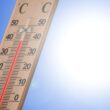Waterspout: Waterspouts are a fascinating and unique natural phenomenon that can occur in many bodies of water around the world. They are often associated with severe weather, including thunderstorms and tropical cyclones, and can be a dangerous sight for those on the water. However, waterspouts are also a beautiful and awe-inspiring display of nature’s power and complexity. In this article, we will explore what waterspouts are, how they form, and some of the scientific and cultural significance of these intriguing weather events.
What is a Waterspout?
A waterspout is a type of tornado that forms over water, typically in the open ocean or near the coast. They can range in size from a few meters to several kilometers in diameter and can last from a few seconds to over an hour. Waterspouts are formed by a rotating column of air, known as a vortex, that extends from the surface of the water to the base of a cumulonimbus cloud.
How Do Waterspouts Form?
Waterspouts form when warm and moist air rises rapidly from the surface of the water and meets colder air aloft. This creates a powerful updraft, which can initiate the formation of a rotating column of air, or vortex. If the vortex extends all the way up to the base of a cumulonimbus cloud, it can become a fully-formed waterspout.
There are two main types of waterspouts: tornadic and non-tornadic. Tornadic waterspouts are similar to tornadoes, and they form when a supercell thunderstorm moves over warm water. Non-tornadic waterspouts, on the other hand, form over water without the presence of a thunderstorm. They are often associated with fair weather and light winds, and they are typically less intense than tornadic waterspouts.
What Do Waterspouts Look Like?
Waterspouts can have different appearances depending on the conditions in which they form. They are typically characterized by a visible column of rotating air that extends from the surface of the water to the base of a cumulonimbus cloud. The column may be thin or wide, and it may be surrounded by a swirling mist or spray.
Waterspouts can also have different colors, ranging from white or gray to brown or even black. This is due to the presence of debris or spray in the air, which can be picked up by the vortex and carried upwards.
Are Waterspouts Dangerous?
Waterspouts can be dangerous for those on the water, as they can cause strong winds, high waves, and lightning strikes. However, most waterspouts are relatively weak and short-lived, and they pose little threat to larger ships and boats.
Tornadic waterspouts, on the other hand, can be more powerful and destructive, with wind speeds that can exceed 200 kilometers per hour. They can cause significant damage to boats, buildings, and other structures, and they can be a serious threat to human life.
How Can You Stay Safe During a Waterspout?
If you are on the water and you see a waterspout, it is important to stay calm and take appropriate safety measures. Here are some tips for staying safe during a waterspout:
- Move away from the waterspout if possible, and try to steer clear of its path.
- If you cannot move away, steer your boat into the wind and waves to minimize the risk of capsizing.
- Keep a safe distance from the waterspout, as it can cause strong winds and high waves.
- If you are on land, seek shelter in a sturdy building or underground shelter if possible.
- Stay away from windows and doors, as they can shatter in high winds.
- If you are in a car, pull over to the side of the road and wait until the waterspout has passed.
It is important to always monitor weather reports and stay informed about the potential for waterspouts in your area. If you are planning to go out on the water, make sure to check the weather forecast and be prepared for changing conditions.
Scientific Significance of Waterspouts
Waterspouts are not just a fascinating natural phenomenon; they also have important scientific significance. They are a critical part of the Earth’s water cycle, as they help to transfer heat and moisture from the ocean to the atmosphere.
Waterspouts can also help scientists to better understand the dynamics of severe weather events, such as thunderstorms and tropical cyclones. By studying the formation and behavior of waterspouts, researchers can gain insights into the processes that drive these powerful storms and develop more accurate models for predicting their paths and intensity.
Cultural Significance of Waterspouts
Waterspouts have been a part of human culture and mythology for thousands of years. In ancient times, they were often seen as supernatural or divine phenomena, and they were sometimes interpreted as omens of good or bad fortune.
In many cultures, waterspouts are associated with sea monsters or other mythical creatures. In the mythology of the Pacific Islands, for example, waterspouts are sometimes seen as the homes of powerful spirits or gods.
Waterspouts have also been the subject of art and literature throughout history. In the 16th century, the Dutch artist Pieter Bruegel the Elder created a famous painting called “The Sea Monster,” which depicts a ship being attacked by a waterspout.
Conclusion
Waterspouts are a fascinating and unique natural phenomenon that can be both beautiful and dangerous. They are formed by a rotating column of air that extends from the surface of the water to the base of a cumulonimbus cloud, and they can be categorized as either tornadic or non-tornadic.
While waterspouts can be a threat to those on the water, they also have important scientific and cultural significance. They are a critical part of the Earth’s water cycle, and they can help scientists to better understand the dynamics of severe weather events. They have also been the subject of art and mythology throughout history, and they continue to capture our imagination and awe.
If you are planning to go out on the water, it is important to be aware of the potential for waterspouts and to take appropriate safety measures. With the right precautions and awareness, you can enjoy the beauty and power of this amazing natural phenomenon while staying safe and informed.
Similar Articles
- Taking Action: Measures to Mitigate Climate Change
- Reforestation: Methods and Strategies for Successful Forest Restoration
- Blue Flag Program: Promoting Sustainable Tourism and Environmental Management
Frequently Asked Questions About Waterspout
- What is a waterspout?
A waterspout is a rotating column of air that extends from the surface of the water to the base of a cumulonimbus cloud.
- How are waterspouts formed?
Waterspouts are formed by a combination of warm, moist air rising from the surface of the water and cool, dry air descending from the cloud above. This creates a rotating column of air that can form into a waterspout.
- What are the different types of waterspouts?
There are two main types of waterspouts: tornadic and non-tornadic. Tornadic waterspouts are more powerful and can cause significant damage, while non-tornadic waterspouts are weaker and generally less dangerous.
- Are waterspouts dangerous?
Waterspouts can be dangerous for those on the water, as they can produce high winds, waves, and lightning. It is important to take appropriate safety measures if you are in an area where waterspouts are possible.
- How can I stay safe during a waterspout?
If you are on the water and see a waterspout, it is important to immediately move away from the area and take shelter if possible. If you are unable to move away from the waterspout, it is best to steer your vessel to the side of the road and wait until the waterspout has passed.
- What is the scientific significance of waterspouts?
Waterspouts are a critical part of the Earth’s water cycle, as they help to transfer heat and moisture from the ocean to the atmosphere. They also help scientists to better understand the dynamics of severe weather events, such as thunderstorms and tropical cyclones.
- What is the cultural significance of waterspouts?
Waterspouts have been a part of human culture and mythology for thousands of years. They have been interpreted as supernatural or divine phenomena and associated with sea monsters or other mythical creatures. They have also been the subject of art and literature throughout history.
- Can waterspouts occur in any body of water?
Waterspouts can occur in any body of water, including lakes, rivers, and even small ponds. However, they are most common in areas with warm, moist air and significant temperature contrasts between the air and water.
- Can waterspouts occur in any season?
Waterspouts can occur in any season, but they are most common during the warm summer months when there is a greater temperature contrast between the air and water.










